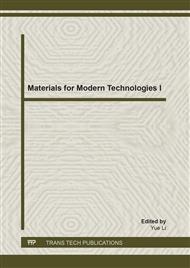[1]
G. Costa, V. Della, M. Ribeiro, Synthesis of black ceramic pigments from secondary raw materials, Dyes Pigments. 13(2011)3511-3514.
DOI: 10.1016/j.dyepig.2007.04.006
Google Scholar
[2]
D. Baralkiewicz, J. Siepak, Chromium, Nickel and cobalt in environmental samples and existing legal norms, Pol. J. Environ. Stud. 8(1999)201-208.
Google Scholar
[3]
C. Peng, C.X. Zhang, M. Lv, Preparation of silica encapsulated carbon black with high thermal stability, Ceram. Int. 39(2013)7247-7253.
DOI: 10.1016/j.ceramint.2013.01.078
Google Scholar
[4]
Y.F. Gao, F. Zhao, Y. Liu, et al, Synthesis and characterization of ZrO2 capsules and crystalline ZrO2 thin layers on Fe2O3 powders, Cryst. Eng. Comm. 13(2011)3511-3514.
DOI: 10.1039/c0ce00989j
Google Scholar
[5]
Q.B. Chang, X. Wang, Y.Q. Wang, et al, Encapsulated carbon black prepared by sol-gel-spraying: A new black ceramic pigment, J. Eur. Ceram. Soc. 34(2014)3151-3157.
DOI: 10.1016/j.jeurceramsoc.2014.03.020
Google Scholar
[6]
C. Graf, D.L.J. Vossen, A. Imhof, et al, A general method to coat colloidal particles with silica, Langmuir. 19(2003) 6693-6700.
DOI: 10.1021/la0347859
Google Scholar
[7]
E. Ozel, S. Turan, Production of coloured zircon pigments from zircon, J. Eur. Ceram. Soc. 27(2007)1751-1757.
DOI: 10.1016/j.jeurceramsoc.2006.05.008
Google Scholar
[8]
P.C. Painter, J. Runt, M.M. Coleman, et al, Effect of polymorphism on the C-H stretching region of the infrared spectrum of polyethylene, J. Polym. Sci. Pol. Phys. 16(1978)1253-1260.
DOI: 10.1002/pol.1978.180160708
Google Scholar
[9]
M.T. Kim, Deposition behavior of hexamethydisiloxane films based on the FTIR analysis of Si-O-Si and Si-CH3 bonds, Thin Solid Films. 311(1997)157-163.
DOI: 10.1016/s0040-6090(97)00683-4
Google Scholar
[10]
S. Raunier, T. Chiavassa, F. Marinelli, et al, Reactivity of HNCO with NH3 at low temperature monitored by FTIR spectroscopy: formation of NH4+OCN-, Chem. Phys. Lett. 368(2003) 594-600.
DOI: 10.1016/s0009-2614(02)01919-x
Google Scholar
[11]
P.D. Bernardo, P.L. Zanonato, S. Tamburini, et al, Functionalisation of silica gel with cyclic and acyclic Schiff bases and related d- and/or f- metal complexes, Inorg. Chim. Acta. 360(2007)1083-1094.
DOI: 10.1016/j.ica.2006.08.012
Google Scholar
[12]
S. Kongwudthiti, P. Praserthdam, W. Tanakulrungsank, et al, The influence of Si–O–Zr bonds on the crystal-growth inhibition of zirconia prepared by the glycothermal method, J. Mater. Process. Tech. 136(2003)186-189.
DOI: 10.1016/s0924-0136(03)00157-2
Google Scholar
[13]
W.H. Jiang, Y. Feng, J.M. Liu, et al, Preparation of ZrSiO4/C inclusion pigments by non-hydrolytic sol-gel method combined with the process of carbon black modification, Mater. Sci. Forum. 745(2013)545-550.
DOI: 10.4028/www.scientific.net/msf.745-746.545
Google Scholar
[14]
N.G. Liu, B.S. Prall, V.I. Klimov, et al, Hybrid gold/silica/nanocrystal-quantum dot superstructures: synthesis and analysis of semiconductor-metal interactions, J. Am. Chem. Soc. 128(2006)15362-15363.
DOI: 10.1021/ja0660296
Google Scholar


